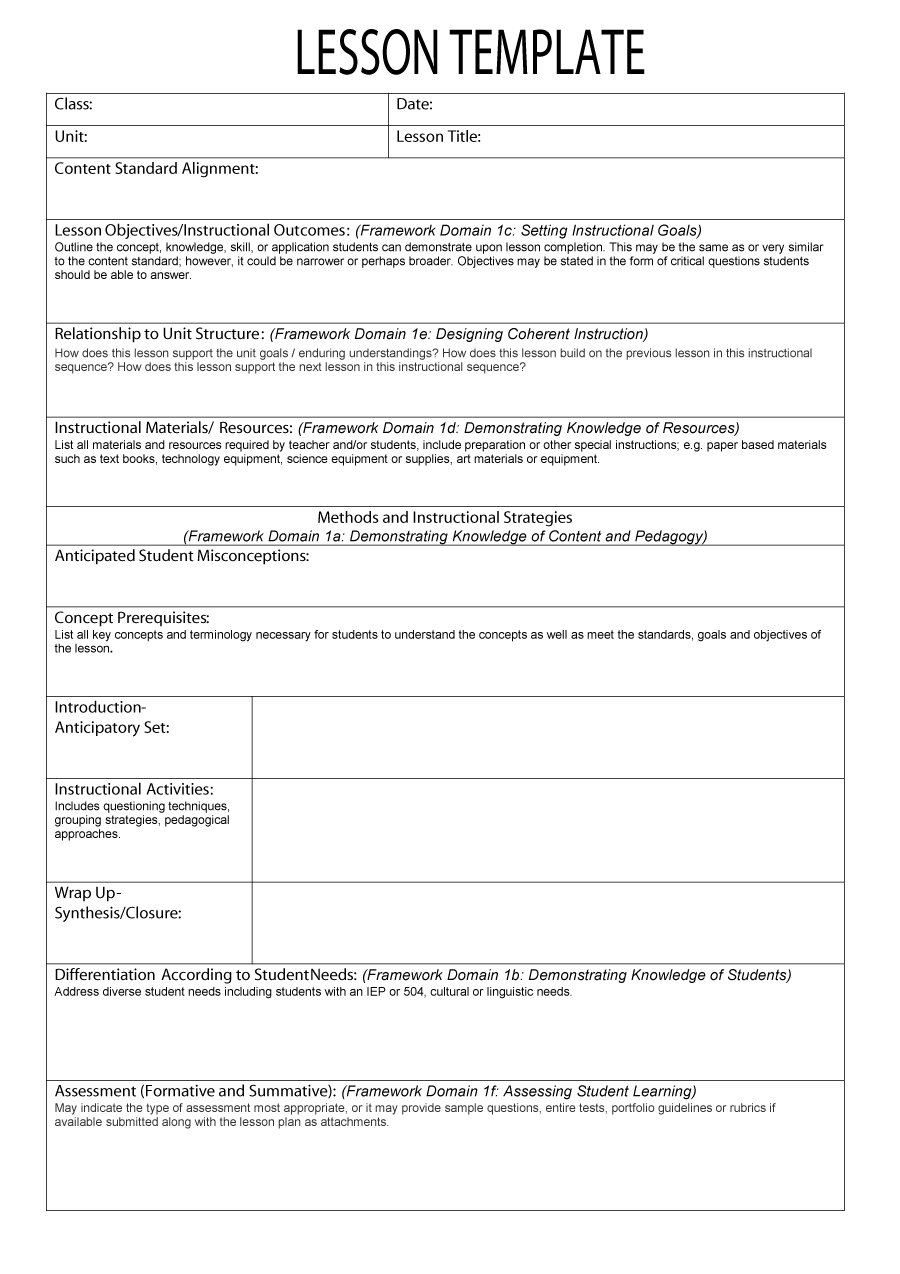Lesson Plan Templates For Teaching Student Assessments

Conducting a class is no child’s play. Aspiring teachers often face the dilemma of organizing their lectures in a way that covers the syllabus effectively. With a systematic lesson plan, your job becomes a lot easier.
A lesson plan is a structure that allows teachers to arrange their classes. It is a basic outline of the day to day activities of the class. There are five main lesson plan formats, depending on the time-period and elements you want to cover.
Here, I will discuss each of these formats in detail, and also give you some tips on how to structure your plan. Other than that, you can also check out the readymade templates for each of these formats.
There are readymade templates that you can download off the internet.
The five-step lesson plan
The five-step lesson plan helps teachers plan out their daily activities. As the name suggests, this format has five main elements or steps.
- Anticipatory set
- Instruction
- Guided practice
- Assessment or closure
- Independent practice
In the anticipatory set, you state the primary objectives of the lesson plan. Begin the plan with a summary of yesterday’s lesson. Then move on to talk about the topics you plan to cover on that day. Keep the language simple, creative, and easy to understand.
The instruction section is where you outline the details of the lesson plan. It is here that you discuss how to implement the lesson. Teachers use this space to demonstrate ways to explain a topic to students. Some also use this section to cover the essential questions to understand the subject.
Guided practice is where you state the activities and group projects that involve peer interaction. Closure or assessment gives the teacher an idea about how the lesson turned out at the end of the day. Here you can include a short quiz to test your students.
Independent practice is the last step or section in the five-step plan. This section is not necessarily a part of the class. Here, the teacher assigns homework or some reference reading for the next level. For the next day, you begin the anticipatory set with a short review of yesterday’s assignment.

Five-E lesson plan
The Five-E lesson plan is another way of formatting your lessons. Here, the focus is more on the teaching methodology and not its implementation. The Five-Es are
- Engaging
- Explaining
- Exploring
- Elaborating
- Evaluating
The process begins with student engagement. Begin your lesson with a question or an interesting fact that piques the interest of the students. With a question or an enquiry, you allow the students to develop their own perspective on the topic.
The next step is explaining where the teacher tactfully directs the lesson towards the curriculum. At the end of the day, you have a syllabus to cover. In this section, you discuss the topic, provide the reading material, and answer some key questions that students pose.
Exploring is when the teacher gives the students time and flexibility to interact with the material. This encourages them to interpret the topic and gather deeper insights into it. You can also include worksheets, projects, and instructional exercises.
The fourth stage, elaboration, is quite similar to the independent practice of the five-step lesson plan. This is where you can include homework, reference reading, and other assignments to check if your students understand the topic.
The last stage, evaluating, is where you test the academic calibre of the student. Exams, unit tests, assessments etc. fall under this category. You can decide the question pattern, marking schemes, dates etc. beforehand as well.

Weekly lesson plan
The Weekly lesson plan is ideal for teachers who plan on continuing the same topic or subject for a week. The format of this plan gives you the space to accommodate all your lectures, exercises, and assignments for the upcoming week.
Begin the lesson plan by stating all the common objectives and purposes for the week. It can include the number of units, chapters, and topics you want to cover. It also consists of any interactive sessions, group assignments etc. that you have in mind as well.
Keep some space to list a summary of the day’s activities. This helps the students how their lessons progress over the week. You can also include an attendance chart to monitor the strength of the class.
The last part of the lesson plan is for recording the marks, assessment grades, homework records and other details. In some institutions, teachers must submit their lesson plan every week, this format might come in handy then.
Unit lesson plan
Unit lesson plans are pretty simple when compared with the other lesson formats listed here. This is because the unit plans are not as elaborate and work well for everyday classes. Here you don’t necessarily have to specify the activities in detail.
The structure is necessary, giving you the provision to outline the day’s activities in an orderly way. The elements are also the same as other lesson plans discussed above. Start the lesson plan by listing the core objectives. Then move on to discuss the topics, the questions, and assignments you plan to cover.
The unit lesson plan is more niche as it gives you an in-depth understanding of the topic and how to best cover it. End the plan with an overview of the lesson. Here, you can include the syllabus covered and the average performance of the class.
Try to keep things as simple and understandable as possible.
Inquiry-based lesson plan
Inquiry-based lesson plans are suitable for science classes and lab sessions. With these lesson plans, you can successfully conduct practical classes, demonstrate experiments and more. The structure, though quite similar to the other layouts, has a few significant deviations.
- The topics covered here are not theoretical but have a very hands-on approach.
- The lesson plan has a section to track the equipment and materials used for experiments.
- You begin the lesson with a list of core objectives expected from the experiment.
- These lesson plans don’t rely on notes or lengthy explanations.
- You present the findings graphically or in a stats-based format.
- It includes objectives, questions, and choice-based assessments.
- You also find a lot of group projects and presentations to cover here.
How to structure a lesson plan?
Lesson plans follow a basic structure that is simple and easy to understand. These plans aim to give teachers some guidelines as to how to conduct a class. So, if you are a novice wondering about how to start your lesson plan, then I got you covered.
Step 1: Introduction
Every lesson plan begins with a simple introduction. This section deals with the primary objectives of the lesson.
- What are the things you want to cover in this lesson plan?
- What is the purpose of your class?
- What subjects and topics do you wish to cover?
These are a few common questions you can ask for a solid introduction. I also recommend teachers to begin their lesson plans with an interesting anecdote or a question to intrigue the reader.
Step 2: Foundation
The next step deals with setting the foundation of the lesson plan. Here, you discuss the various topics and sub-topics to discuss during the class. List the projects, video classes, reading material and assignments decided for the class as well.
I always ask aspiring teachers to begin from the basics. Try to keep things as simple and understandable as possible.

Step 3: Brainstorming
The third step is brainstorming, where you consult your peers and seniors about what to include in your lesson plan. Planning and conducting a session with students is easier said than done. There are a lot of elements you need to consider.
- What is the strength of the class?
- How many topics do you have to complete?
- How do you intend to divide the syllabus?
- How can you make the lessons informative and interesting?
- What extra reading material and references can you provide?
- How to assess the students?
- What should be the marking scheme?
- How do you gauge the performance and success rate of any lesson?
Also, while we are at it, learn to be tech-savvy. There are multiple tools and apps to help teachers organize their lessons, create, and distribute worksheets and manage assessments.
Step 4: Collecting information
The fourth step is about collecting all the details required to conduct a session with the students. Ask your students about the previous topic and what they already know about the current curriculum. This gives you an idea about how well-versed your class is.
Here you also introduce some key terms and essential phrases about the topic at hand. Build a solid vocabulary for a comprehensive learning experience.
Step 5: Arranging information
There was a time when teachers had to plan out their lessons on paper. This was quite a cumbersome task. Thanks to technology, you don’t have to invest all that time and effort. There are readymade templates that you can download off the internet.
Quick Links And References


